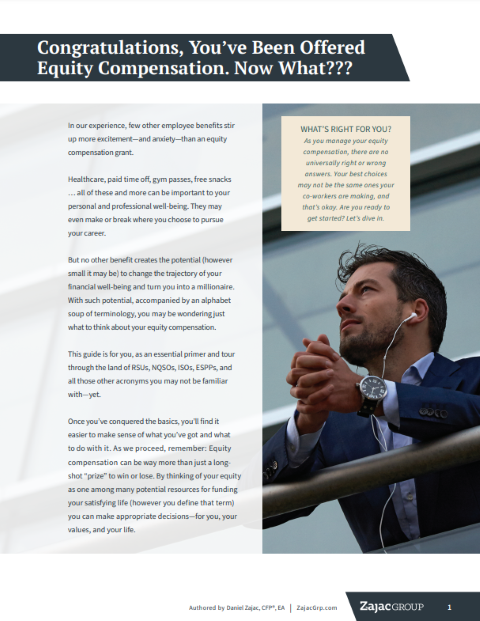You can develop concentrated equity positions in your investment portfolio when you own or control a single stock that makes up a significant part of your overall allocation. While there are many reasons this can happen, one common way people find themselves with a concentrated position is when they receive equity compensation.
Employee stock options, restricted stock units, or other company equity that you may receive create the opportunity to participate in the growth of your company if the company’s share price rises. But that benefit also means it’s quite easy to end up with a concentrated equity position in your portfolio.
That can work out in your favor assuming the stock does well — but it also leaves you exposed to the downside risk of the company stock price falling or underperforming.
Given the need to strike that balance, what should you do if you find yourself with a large position of one company stock? Consider taking these steps to better manage concentrated equity via your stock options, shares, or RSUs.
Step 1: Understand What Type of Equity Comp You Can Receive, and What You Already Own
To best manage your equity compensation, you need to know exactly what you have and what shares you may already own. Some common forms of company stock ownership and stock rights include:
- Outright ownership of company stock
- Company stock as part of an employee stock purchase plan (ESPP)
- Restricted stock units (RSUs) or awards
- Incentive stock options (ISOs)
- Non-qualified stock options (NQSOs)
The rules and regulations governing each type of company stock ownership, including when and how taxes come into play, tend to vary depending on what you have. This information is critical to know before you can develop a strategic plan for managing your equity.
In addition to knowing what you have, you’ll want to know what may have already occurred with your equity compensation. Things to look for include vesting schedules, purchase dates, exercise history, tax withholding, and settlement of shares.
For example, if you exercised NQSOs or ISOs in the past, you’ll want to know what the strike price was for the option, the fair market value at exercise, and the corresponding tax information. Without these details, it’s difficult to evaluate where you are and where you may want to go from here.
Step 2: Calculate the Cost Basis of Stock You Own Outright
The cost basis of your stock is what you paid to acquire the shares. Cost basis plays a big role in determining how much income tax you’ll owe if you sell those shares.
If you have incentive stock options, the idea of cost basis gets a little more complicated. You may have a regular cost basis associated with the shares you received when you exercised your ISOs, as well as an alternative minimum tax (AMT) cost basis. You should track both these numbers until you liquidate shares, as they both influence your total tax bill.
Cost basis can also get complicated if you need to account for net unrealized appreciation (which involves the tracking of cost basis for company stock purchased inside a 401(k) plan), or the fact that every single share you own may have its own cost basis that must be calculated separately.
Once you understand your cost basis, you can estimate how much you’ll owe in taxes — and from there, you can figure the net proceeds you’ll receive after a stock sale. The net amount is how much you’ll have available to spend, reinvest, or allocate to other goals.
Step 3: Identify Key Event Dates
There are several key dates associated with every type of equity compensation that you should know.
If you own company stock outright, you’ll want to pay attention to the purchase date of the stock. That’s used to determine whether any realized gains or losses will be taxed under ordinary income tax rates (if it’s a short-term gain or loss), or at long-term capital gains rates that can be lower (often 15%, but the rate ranges from 0% to 20% in 2021), if you sell your shares.
Other important dates may include vesting dates, expiration dates, and dates associated with a qualified disposition of ESPP and ISO stock.
A vesting schedule is commonly used to determine when you can take action with an option, or when the value of a grant or stock options becomes yours.
Prior to the shares vesting, you only have a future promise should you meet certain criteria. Once vested, that promise is fulfilled and you gain the ability to control your shares. For stock options, a vesting schedule often informs when you can exercise your option. For RSUs, the vesting schedule often determines when the taxable event occurs.
The expiration date of employee stock options is the date your right to exercise the option ceases. If the fair market value of the stock is above the strike price of the stock option, you probably want to exercise the option at some point before expiration date. If you don’t, you forfeit the potential value at that date.
If your stock options are underwater at the expiration date, exercising doesn’t make any sense. The stock options will expire as worthless to you.
You also need to know the dates associated with qualified dispositions. For shares that you received through an employee stock purchase plan, or shares you received by exercising incentive stock options, meeting the standard required of a qualified disposition may provide some tax advantages.
However, seeking a tax advantage requires assuming more investment risk because you’re holding the shares rather than selling. That exposes you to normal market risk associated with any investment and potential volatility in the stock price. It may also expose you to concentration risk, depending on how much the company stock position you have represents your overall portfolio.
Depending on the performance of the stock over time, which no one can predict in the present moment, you risk losing more in the market than you would have paid in taxes under a disqualifying disposition (in which you do not receive a lower tax rate on the proceeds of selling your shares).
Step 4: Determine If You Have a Concentrated Equity Position in Company Stock
Concentration risk is the risk of owning too much of a single equity, including company stock. While it does represent a risk, maintaining some degree of portfolio concentration isn’t an inherently bad strategy. By taking on more risk, you also open the door for higher upside potential.
Risk and reward are related. When the company is doing well and valuations are going up, you will likely benefit from a concentrated position. However, during periods of poor company performance, concentration in a single stock can lead to a meaningful loss of wealth.
It’s important to understand how much concentration risk you have, versus how much concentration risk you can actually afford to take (and feel comfortable taking). One common rule of thumb is to keep exposure to any one company to no more than 10-15% of your overall portfolio
But that’s just one guideline, and you might want to stick to a different rule of thumb when the stock in question is associated with the same company that also signs your paychecks. A more complete analysis of proper concentration risk for your own portfolio may need to account for details like your overall net worth, your liquidity needs, your life stage, and your future plans.
Step 5: Plan for Concentration Risk and Financial Planning
Managing your overall investment portfolio and financial plan requires a thorough analysis of your company stock and employee stock options. By combining the details of your equity with the goals of your financial plan, it’s possible to create an arrangement that strives to maximize value.
While there is no assurance that reallocating your portfolio to a diversified pool of investments will produce better returns or will protect against loss, a diversified portfolio may reduce a portfolio’s volatility and be a more suitable investment to help you meet your long-term financial needs.
With so many moving parts, it’s easy to understand why you may feel overwhelmed. The combination of a large portion of wealth in one stock, a lack of clarity on every single tax rule and implication, and the fear of making a mistake can leave even the most sophisticated investor paralyzed.
Managing concentrated equity positions is often difficult and complex, and may require the balancing of continuous monitoring and a deep understanding of your specific plan rules, tax rules that may apply, selling restrictions, the overall impact of all your actions on your complete investment portfolio.
While a few people can successfully manage all the nuances here on their own, far more benefit from the guidance and advice of qualified, experienced financial professionals.










I always sold my stock appreciation rights as soon as I could. Except when I retired early the company had a very big year so my salary plus bonus was very large and I knew the next year my retirement side gigs would be less so I delayed selling $60,000 worth by one month to get into January vs December. Sounds smart, right? Well in that one short delay the stock tanked and they went under water and then expired. Trying to save less than $10,000 in taxes cost me the whole $60,000. I strongly recommend selling as soon as possible. Your company stock can fluctuate far more wildly than any index and you have too many eggs in your work related basket when you are invested in your company stock.
Thanks for sharing your story Steve. And sorry to hear it. That’s the risk of concentrated equity. When it works, it may work well. But when it doesn’t, you may experience a loss like yours.
Fortunately for you, it sounds like not all your wealth was tied up.